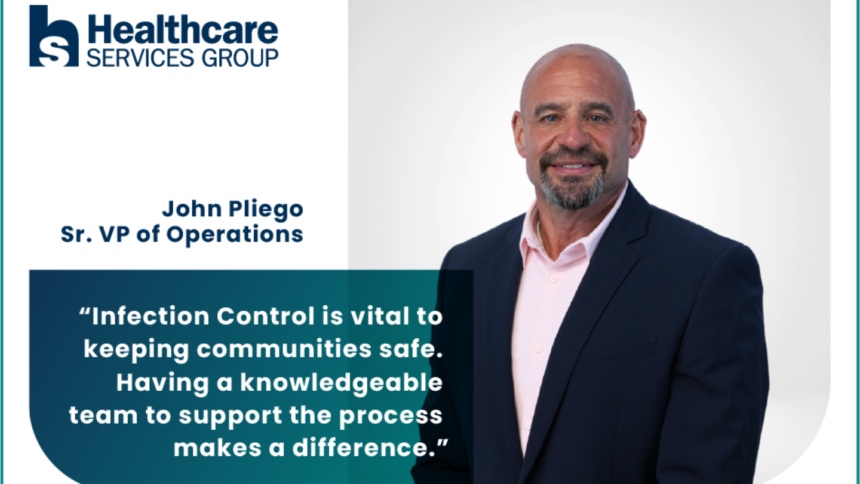
[Partner content]
In this interview, John Pliego, Sr. Vice President of Operations at Healthcare Services Group (HCSG), discusses the importance of establishing and maintaining a successful Infection Prevention and Control program and how doing so can elevate resident experience. Pliego is responsible for the environmental services operations of most of the United States. He began his career with HCSG in 1990 as a Manager-in-Training and has spent the last three decades in various operational roles supporting the environmental and dining operations. Pliego holds a Bachelor of Science in Finance from St. John’s University. He resides in Connecticut and enjoys spending time with his wife, five daughters, and grandson.
What are your thoughts on the need for a robust Infection Prevention and Control (IPC) process in skilled nursing and how it might impact the industry as a whole?
Infection Prevention and Control processes are paramount in skilled nursing facilities because their residents and patients require stringent measures to protect their health. Complying with regulatory standards ensures a safe environment for everyone living, working, or visiting these communities. By emphasizing proper hygiene practices, environmental cleanliness, and staff training, skilled nursing facilities can create a comprehensive infection prevention framework that promotes resident well-being and upholds the highest standards of care.
What are the components of a successful IPC program?
A robust IPC program relies on key components seamlessly integrated into a comprehensive framework. The first that comes to mind is the meticulous process and procedures that serve as the foundation, encompassing protocols from hand hygiene and environmental cleaning to isolation precautions.
Placing a strong emphasis on training is also imperative for IPC, with ongoing education initiatives and hands-on skill development ensuring that health care personnel can effectively implement infection prevention measures and hold themselves accountable. Every fundamental component of the processes and procedures should be identified and fleshed out with specific instructions and best pest practices, all the way down to the proper use of Personal Protective Equipment (PPE).
Lastly, having systems in place to monitor activity and collect and analyze data will help identify areas of improvement, empowering facility leaders to adjust and implement necessary measures to achieve the best outcomes in each resident’s care journey.
Ultimately, a successful IPC program aims to minimize the risk of infections while upholding the highest safety standards for all.
Why is the relationship between a well-run Environmental Services (EVS) team and a facility’s IPC processes so important?
An environmental services team that effectively understands the IPC processes is critical to ensure adherence to stringent cleanliness standards across the entire facility. The EVS team significantly contributes to the safety and well-being of residents and staff through meticulous cleaning and disinfection protocols, and their responsibility in infection prevention cannot be overstated.
Further, the impact of an EVS resonates beyond regulatory requirements alone. A well-maintained environment positively impacts aesthetics and comfort, influencing the overall resident experience and perception of the facility’s quality of care.
Why is it important for training to be top of mind, specifically for the EVS department?
A well-trained EVS team can maintain cleanliness and sanitation to help the facility drive results, but training is also the bedrock for regulatory compliance. Focusing on training ensures that teams are well-versed in cleanliness standards and equipped to meet regulatory requirements while simultaneously honing their efficiency and effectiveness. In emergencies, such as infectious disease outbreaks, well-prepared teams can swiftly implement measures to protect residents and staff, especially when they are familiar with streamlined processes and the safe use of cleaning equipment and chemicals.
Training also plays a pivotal role in promoting a culture of excellence within the team, instilling pride, professionalism, and encouraging open communication and collaboration.
Meeting the ever-changing regulatory requirements can undoubtedly seem daunting; how can partnering with a service provider like Healthcare Services Group (HCSG) give facility leaders peace of mind?
HCSG’s foundation begins with our Environmental Services. For almost 50 years, we have been at the forefront, supporting infection prevention and control initiatives for housekeeping and laundry departments in thousands of communities nationwide. Our comprehensive hands-on training, quality assurance measures, a multi-level management support system, detailed performance evaluation and reporting, allow us to meet our clients and resident communities’ highest satisfaction.
Partnering with HCSG offers facility leaders a strategic advantage in managing the complexities of evolving regulatory requirements within the industry. Our training, compliance, and operational procedures are structured to meet the rigorous local, state, and federal requirements guided by agencies such as the Centers for Medicare & Medicaid Services and the Centers for Disease Prevention and Control. However, we don’t just tell them about the changes. As their partner, we foster a culture of continuous improvement, implement the necessary measures, and train employees at every level to achieve and maintain compliance.
Our goal is to be an extension of the facility leadership team, helping streamline operations and optimize resources, enabling facility staff to concentrate on core health care responsibilities.
How does having a satisfactory IPC program impact resident satisfaction and census growth?
An effective IPC program contributes to the well-being and comfort of residents. It also builds trust with their families. Communicating the IPC program is essential to residents and their families, but even more important is for them to physically see facilities deliver on their commitment to keep residents safe and comfortable just as they would be in their homes.
Similarly, a facility known for its commitment to infection prevention becomes an attractive choice for new residents seeking a safe and healthy living environment. Families researching skilled nursing facilities prioritize those with strong infection control measures, positively influencing the facility’s reputation and allowing them to welcome new residents to their community.
_____________
With a heritage of excellence spanning half a century, HCSG serves the dining and environmental needs of healthcare communities. As a partner possessing proven systems, innovative resources, and dedicated team members who go beyond traditional expectations, HCSG delivers truly exceptional experiences and enhanced outcomes. Learn more at HCSG.com.




